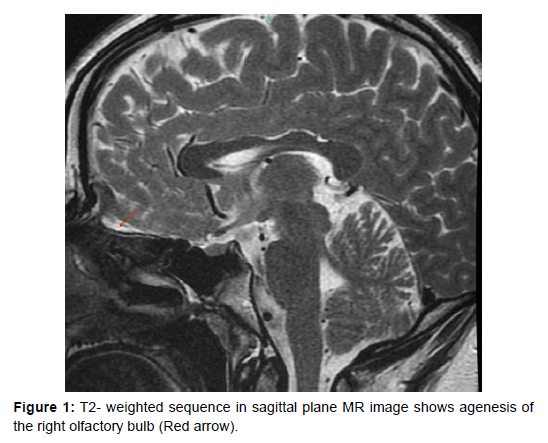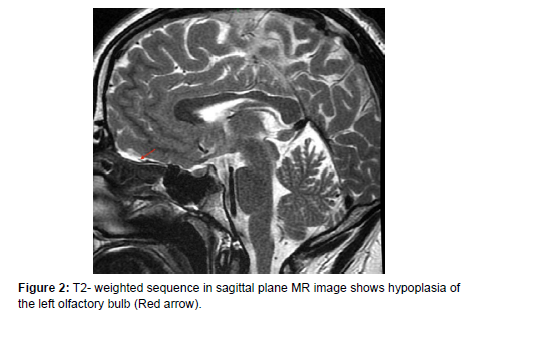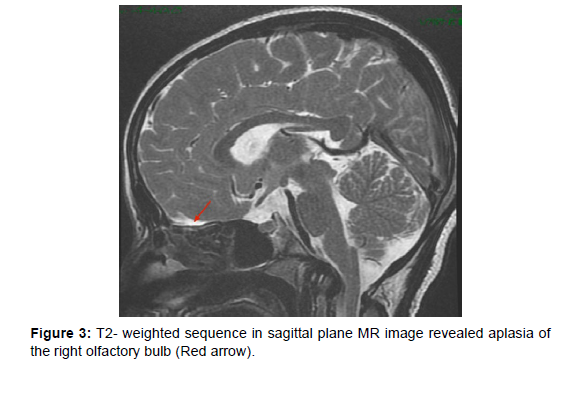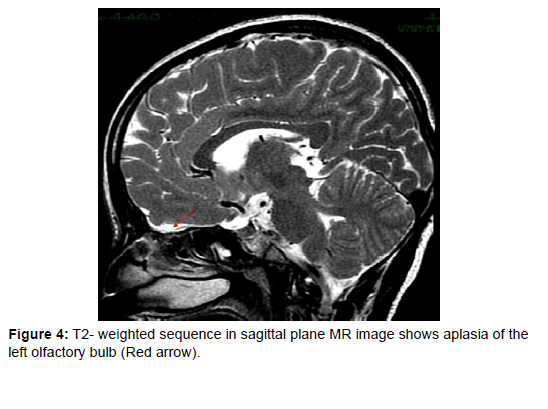Kallmann Syndrome: About Two Cases
Received: 05-Aug-2023 / Manuscript No. roa-23-110427 / Editor assigned: 07-Aug-2023 / PreQC No. roa-23-110427 (PQ) / Reviewed: 21-Sep-2023 / QC No. roa-23-110427 / Revised: 24-Aug-2023 / Manuscript No. roa-23-110427 (R) / Published Date: 31-Aug-2023 DOI: 10.4172/2167-7964.1000475
Abstract
Kallmann syndrome is a rare genetic disorder characterized by hypogonadotropic hypogonadism associated with anosmia or hyposmia. It is a disorder of neuronal migration. Magnetic resonance (MR) imaging is used to visualize the olfactory pathways and to evaluate the olfactory stool. Magnetic resonance (MR) imaging is used to visualize the olfactory tracts and to evaluate the olfactory sulci. We report 2 cases of patients with this syndrome.
Keywords
Kallmann syndrome; Hypo gonadotrophic hypogonadism; Anosmia; Magnetic resonance imaging; Olfactory system
Introduction
The kallmann syndrome (KS) or olfacto genital syndrome is a rare genetic disorder characterized by the association of a hypogonadotropic hypogonadism by deficit in gonadotropin-releasing hormone (GnRH) and anosmia or hyposmia (secondary to a hypoplasia or aplasia of the olfactory bulbs. It was described by Maestre de San Juan in 1856 and characterized as a hereditary condition by Franz Josef Kallmann in 1944 [1]. The prevalence is estimated at one in 10,000 males and one in 50,000 females [2].
The diagnosis is most often made during adolescence when there is an absence of spontaneous puberty associated with a disorder of the sense of smell, with visualization on hypothalamic-pituitary MRI of hypoplasia or even aplasia of the bulbs and/or olfactory lobes with hormonal treatment, puberty occurs in all cases, and fertility can be achieved in most cases. In the present study, we report 2 cases of Kallmann syndrome.
Case Report
Case 1
22-year-old women, was admitted to the endocrinology department for exploration of secondary amenorrhea associated with short stature. The history of the disease goes back to the age of 14 years by the observation of a small size compared to her classmates. The evolution was marked by the installation of a secondary amenorrhoea one year later at the age of 15 years. Clinical examination found a severe failure to thrive and Tanner 3 associated with hyposmia.
Full endocrine evaluation was done which revealed low levels of serum: estradiol < 10pg/ml FSH 6mUI/ml LH 1.98mUI/ml. Pelvic ultrasound shows a normal size and morphology of the uterus and the follicular ovaries.
The Brain MRI showed agenesis of the right olfactory bulb (Figure 1) and a hypoplasia of the left olfactory bulb (Figure 2) and there was no pituitary or hypothalamic lesion. The patient was on hormone replacement therapy with the appearance of regular menstrual cycles. Case 2
19-years-old men, follow-up for diabetes type 1 who presented an impuberance with notion of anosmia; in whom the clinical examination shows an overweight, impubescent patient with small intra-scrotal testicles, a micropenis, an absent pilosity and axillary.
In the biological assessment a hypogonadotropic hypogonadism was noted: FSH=0.27mUI/ml (0,95-11,95) LH=0.15mUI/ml (1,14- 8,75), ow testosterone level à 0.6ng/ml.
The MRI of brain revealed aplasia of the right (Figure 3) and left olfactory bulb (Figure 4) and there was no pituitary or hypothalamic lesion. The patient was put on androgen therapy (Testosterone) with a good clinical evolution.
Discussion
Kallmann syndrome (KS) describes the association of isolated hypogonadotropic hypogonadism (HH) with hypo/anosmia. The association of hypogonadism and anosmia was first described in 1856 by Maestre de San Juan [3]. KS is due to a defect in the development of the olfactory system which normally guides the neuroendocrine cells synthesizing the gonadoliberin GNRH from the nose to the hypothalamus-pituitary region, so KS can be defined as a defect of migration of the neuroendocrine cells producing GNRH due to aplasia or hypoplasia of the olfactory bulbs and tracts [4,5].
Both clinically and genetically, Kallmann is heterogeneous; and although most cases are sporadic three modes of inheritance have been reported: X-linked recessive, autosomal dominant and autosomal recessive [2 ]. The symptomatology of KS is variable according to the sex and the importance of the deficit.
KS is suspected in boys when there is unilateral or bilateral cryptorchidism and/or micropenis during the neonatal period and in girls KS is revealed by primary amenorrhea in more than 90% of cases; breast development is highly variable; pubic hair may be absent, sparse or even normal.
Blood test is necessary, in case of suspicion of KS, which will reveal hypogonadotropic hypogonadism (hypo testosteronemia in boys and low serum estradiol concentrations in girls), with low or paradoxically normal plasma LH and FSH levels.
However, the diagnosis may be difficult to establish in patients of pre-pubertal age and may require genetic testing and MRI. MRI is the modality of choice for visualizing the agenesis or hypo/ atrophy of olfactory bulbs. In the mid-90s, the pioneering works by Yousem et al. demonstrated the ability of MRI to yield accurate volumetric measurements of the olfactory bulb in various pathological conditions [6].
High resolution coronal fast spin echo T2- and T1-weighted images are the preferred sequences for a morphologic evaluation of the olfactory system [7]. Olfactory bulbs are normally seen as well-defined structures along cribriform plate. Olfactory sulci are seen between gyrus rectus and medial orbital gyrus [8 ].
Vogl et al. documented the ability of MR imaging to demonstrate abnormalities of the olfactory pathway in patients with congenital anosmia [9]. A study by Bhatnagar et al. (1987) of 8 cadavers of white females aged 25-102 years indicated that the length of the olfactory bulbs varied from 7.9 to 14.5 mm, depending on the individual, with a width of about 4.4 mm. The average bulb volume estimates were 50 mm3 (25 years), 43 mm3 (60 years) and 36 mm3 (95 years), suggesting a decrease with age [10].
There are other congenital disorders associated with decreased olfaction, including holoprosencephaly, Down syndrome, Turner syndrome, and Riley-Day syndrome. However, complete absence of the bulbs and olfactory tracts has only been well documented in Kallmann syndrome [11].
The treatment of hypogonadism in KS aims first to initiate virilisation or breast development, and second to develop fertility. Hormone replacement therapy, usually with testosterone for males and combined oestrogen and progesterone for females, is the treatment to stimulate the development of secondary sexual characteristics. For those desiring fertility, either gonadotropins or pulsatile GnRH can be used to obtain testicular growth and sperm production in males or ovulation in females [12]. There is presently no treatment for hyposmia as it is due to the pathology in the olfactory bulbs.
Conclusion
KS is a rare pathology characterized by the association of a hypogonadotropic hypogonadism and anosmia or hyposmia. MR imaging is necessary to detect the abnormalities of the olfactory system, which are always present among patients suffering from Kallmann syndrome. Hormonal treatment lead to restore normal pubertal development and in some case normal fertility.
References
- Arkoncel MLCR, Arkoncel FR, Lantion-Ang FL (2011) A case of Kallmann syndrome. BMJ Case Rep 2011: bcr0120113727.
- Ahmed R, Saha SK, Dutta P (2020) Kallmann Syndrome: A Case Report. British J Med Health Res 7: 96-101.
- Ribeiro RS, Vieira TC, Abucham J (2007) Reversible Kallmann syndrome: report of the first case with a KAL1 mutation and literature review. Eur J Endocrinol 156: 285-290.
- Arkoncel MLCR, Arkoncel FRP, Lantion-Ang FL (2011) A case of Kallmann syndrome. BMJ Case Rep 2011: bcr0120113727.
- Doraiswamy PM, Potts JM, Axelson DA, Husain MM, Lurie SN, et al. (1992) MR assessment of pituitary gland morphology in healthy volunteers: Age and gender related differences. AJNR Am J Neuroradiol 13: 1295-1299.
- Yousem DM, Turner WJ, Li C, Snyder PJ, Doty RL (1993) Kallmann syndrome: MR evaluation of olfactory system. AJNR Am J Neuroradiol 14: 839-843.
- Zaghouani H, Slim I, Zina NB, Mallat N, Tajouri H, et al. (2013) Kallmann syndrome: MRI findings. Indian J Endocrinol Metab 17: S142-145.
- Warner MD, Peabody CA, Berger PA (1988) Olfactory deficits and down’s syndrome. Biol Psychiatry 23: 833-839.
- Vogl TJ, Stemmler J, Heye B, Schopohl J, Danek A, et al. (1994) Kallman syndrome versus idiopathic hypogonadotropic hypogonadism at MR imaging. Radiology 191: 53-57.
- Bhatnagar KP, Kennedy RC, Baron G, Greenberg RA (1987) Number of mitral cells and the bulb volume in the aging human olfactory bulb: A quantitative morphological study. Anat Rec 218: 73-87.
- Zaghouani H, Slim I, Zina NB, Mallat N, Tajouri H (2013) Kallmann syndrome: MRI findings. Indian J Endocrinol Metab 17: S142-S145.
- Dodé C, Hardelin JP (2009) Kallmann syndrome. Eur J Hum Genet 17: 139-146.
Indexed at, Google Scholar, Crossref
Indexed at, Google Scholar, Crossref
Indexed at, Google Scholar, Crossref
Indexed at, Google Scholar, Crossref
Indexed at, Google Scholar, Crossref
Indexed at, Google Scholar, Crossref
Indexed at, Google Scholar, Crossref
Indexed at, Google Scholar, Crossref
Citation: Rostoum S, Imrani K, Zhim M, Chorfa SH, Naggar A (2023) KallmannSyndrome: About Two Cases. OMICS J Radiol 12: 475. DOI: 10.4172/2167-7964.1000475
Copyright: © 2023 Rostoum S, et al. This is an open-access article distributedunder the terms of the Creative Commons Attribution License, which permitsunrestricted use, distribution, and reproduction in any medium, provided theoriginal author and source are credited.
Share This Article
Open Access Journals
Article Tools
Article Usage
- Total views: 1459
- [From(publication date): 0-2023 - Mar 31, 2025]
- Breakdown by view type
- HTML page views: 1241
- PDF downloads: 218




